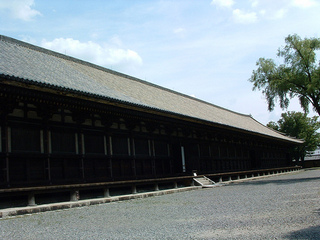Difference between revisions of "Sanjusangendo"
| Line 3: | Line 3: | ||
*''Japanese'': 三十三間堂 ''(san juu san gen dou)'' | *''Japanese'': 三十三間堂 ''(san juu san gen dou)'' | ||
| − | The Sanjûsangendô (lit. "Hall of 33 Bays") is a Buddhist | + | The Sanjûsangendô (lit. "Hall of 33 Bays") is a Buddhist temple of the [[Pure Land Buddhism|Pure Land sect]] located in Kyoto. Built in [[1164]] by [[Taira no Kiyomori]], it is thirty-three bays long (about 120 meters) by four bays deep, the width of "bays," i.e. the space between the pillars in a building, being standardized in traditional Japanese architecture. |
Due to the great length of the hall, its exterior porch has long been the site of [[archery]] competitions. The competition centered not on hitting a bull's eye or other target with exceptional precision or accuracy, but rather on firing as many arrows as possible within a limited time, and on having as many of those arrows as possible fly the full length of the hall without striking the floor, walls, pillars, or ceiling of the porch. The standing record dates back to [[1686]], when a competitor is said to have loosed 13,053 arrows down the length of the building, of which 8,133 were successfully shot the full length of the building without touching it. | Due to the great length of the hall, its exterior porch has long been the site of [[archery]] competitions. The competition centered not on hitting a bull's eye or other target with exceptional precision or accuracy, but rather on firing as many arrows as possible within a limited time, and on having as many of those arrows as possible fly the full length of the hall without striking the floor, walls, pillars, or ceiling of the porch. The standing record dates back to [[1686]], when a competitor is said to have loosed 13,053 arrows down the length of the building, of which 8,133 were successfully shot the full length of the building without touching it. | ||
| Line 15: | Line 15: | ||
==References== | ==References== | ||
*Ching, Francis D.K. et al. ''A Global History of Architecture''. Second Edition. John Wiley & Sons, 2011. p398. | *Ching, Francis D.K. et al. ''A Global History of Architecture''. Second Edition. John Wiley & Sons, 2011. p398. | ||
| + | |||
| + | ==External Links== | ||
| + | *[https://maps.google.com/maps?q=%E4%BA%AC%E9%83%BD%E5%B8%82%E4%B8%89%E5%8D%81%E4%B8%89%E9%96%93%E5%A0%82&hl=en&ie=UTF8&ll=34.987983,135.771822&spn=0.004703,0.010568&sll=37.0625,-95.677068&sspn=37.188995,86.572266&t=h&hq=%E4%BA%AC%E9%83%BD%E5%B8%82%E4%B8%89%E5%8D%81%E4%B8%89%E9%96%93%E5%A0%82&z=17 Sanjûsangendô on Google Maps]. | ||
[[Category:Temples]] | [[Category:Temples]] | ||
[[Category:Kamakura Period]] | [[Category:Kamakura Period]] | ||
Revision as of 17:46, 27 May 2012
- Built: 1164, Taira no Kiyomori
- Japanese: 三十三間堂 (san juu san gen dou)
The Sanjûsangendô (lit. "Hall of 33 Bays") is a Buddhist temple of the Pure Land sect located in Kyoto. Built in 1164 by Taira no Kiyomori, it is thirty-three bays long (about 120 meters) by four bays deep, the width of "bays," i.e. the space between the pillars in a building, being standardized in traditional Japanese architecture.
Due to the great length of the hall, its exterior porch has long been the site of archery competitions. The competition centered not on hitting a bull's eye or other target with exceptional precision or accuracy, but rather on firing as many arrows as possible within a limited time, and on having as many of those arrows as possible fly the full length of the hall without striking the floor, walls, pillars, or ceiling of the porch. The standing record dates back to 1686, when a competitor is said to have loosed 13,053 arrows down the length of the building, of which 8,133 were successfully shot the full length of the building without touching it.
The hall contains 1000 gilded wooden sculptures of Kannon, flanking one larger central Kannon sculpture, along with twenty-eight additional figures of various Buddhist deities. The building, and many of the sculptures, were severely damaged during the Genpei War (1180-1185); the sculptures created in the early 13th century by Tankei and other members of the Kei school to replace those lost are often cited as some of the greatest surviving examples of Kamakura period sculpture.
An earthenwork wall in the Sanjûsangendô compound is counted among the Three [Great] Earthenwork Walls of Japan, alongside one built by Oda Nobunaga at Atsuta Shrine in Nagoya, and one at Nishinomiya Shrine.
References
- Ching, Francis D.K. et al. A Global History of Architecture. Second Edition. John Wiley & Sons, 2011. p398.
